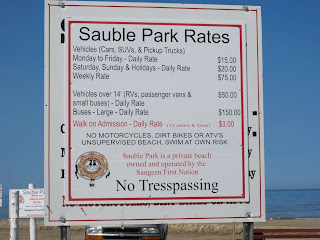We drove to Tobermory, but did not take the glass bottomed boat over the wrecks. Instead we inquired about native orchids as there are supposed to be over 40 species hereabouts. We were directed to the boardwalk at Singing Sands. On the way there, Bill managed to spot Yellow Slipper Orchids from the car - a pretty good effort. At Singing Sands people were retreating from the boardwalk as a rattlesnake had been seen and heard. We saw lots of carnivorous plants (drosera?) in the swampy ground beside the boardwalk and later on another track some pink orchids.
Yellow slipper orchid. The slipper is about 3 or 4 cm across.
Pink slipper orchids. These also are large and showy.
My excuse for the poor focus of the pink slipper orchid photo was the mud and the likelihood of meeting a rattlesnake.
Sauble Beach - one of Canada's top ten beaches! I guess it is all relative, it would not rate in Western Australia.
The First nation person on the gate, came and invited us Seniors to walk on the beach for free which was very kind.
Midland is a very historic area and we went first to Discovery Harbour at Penetanguishene. We had a great guide Jon, around the reconstructed British naval base of 1817 (keeping the Americans away). Apart from the buildings, there are two tall ships (small ones). Kingston was the main naval base and Penetanguishene was never very large and would have been very remote. After the navy closed the base in 1828,the army remained there until the 1850s.
HMS Tecumseth, Discovery Harbour, Penetanguishene
The Quarterman complete with his 19thC woodworking tools, Penetanguishene
On Tuesday,we went to
Sainte-Marie among the Hurons just outside Midland. The Jesuits
established a mission here in 1639. It was 1300 km, 30 days by canoe
up the St Lawrence and Ottowa Rivers etc. with 50 portages west from
Quebec. For a while the settlement thrived, but the warlike Iriquois attacked and two of the Jesuits were murdered. A couple of years later the Jesuits abandoned the site after burning it to the ground. They thought there was a fair chance their murdered companions would later be canonised, so they dug up their bones and took them back to Quebec, so that they would be available as relics. I don't think this fits with the idea of Rest in Peace which surely they deserved, but different times, different ideas. Incidentally they did become saints in 1930.
Wendat (called Huron by the French) longhouse on the left and a tepee on the right. In the background the chapel built by the Jesuits. The Wendat were an agricultural and matrilineal people who lived communally in palisaded villages.They grew corn, beans and squash.
Using threads of spruce root to sew together sheets of birch bark to repair the wigwam in the photo below. Such a structure would typically last about 5 or 6 years.
At both of these sites, the
costumed staff were fabulous, very well informed and friendly and
mostly completely bilingual. There were a lot of francophone tourists
and they switched seamlessly back and forth between English and French.











No comments:
Post a Comment